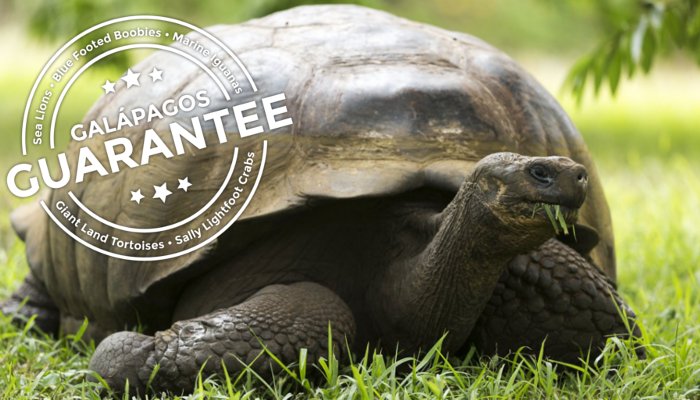
GALAPAGOS GIANT TORTOISE
A Galapagos Guarantee Creature!
In a world of incredibly unique, stunning fauna, it says something when you’re the most famous of the lot. Of all the fauna the Galapagos offers, the archipelago’s giant tortoises are perhaps the most recognizable and the most beloved. So beloved that the islands were named after the lumbering creatures; the Spanish word galapago translates to “saddle,” a term the early explorers applied to the tortoises upon seeing their shells.
Galapagos giant tortoises are aptly named as they are indeed rather giant. With some tortoises reaching over 5 feet in length and growing to reach up to 700 pounds, it’s hardly surprising that they’re the largest tortoises in the world. It’s also quite handy that they can’t fall on you. Walk among these leisurely giants on our Galapagos Island Vacation.
When Darwin first breached the shores of the Galapagos, he found 14 different species of giant tortoises living throughout the archipelago. Currently, only 11 different species survive. Over the course of the 17th, 18th, and 19th centuries, an estimated 100,000 tortoises were killed by visiting merchants, pirates, and whalers. Even when humans weren’t delivering the killing blows or abducting them from their island homes, feral populations of pigs, dogs, cats, goats, rats, and cattle have decimated much of their food supply as well of their eggs. Only about 20-25,000 giant tortoises are alive today.
Perhaps the most prominent loss of a Galapagos giant tortoise species was the loss of Lonesome George, a Pinta Island subspecies who was brought to the Charles Darwin Research Station in 1971 and survived until 2012. Though the Galapagos National Park attempted to find George a mate and save the species, their efforts ultimately failed. With Lonesome George’s death at over 100 years old, the Pinta Island tortoises went extinct.
In order to combat this devastation, the Galápagos National Park Directorate, the Charles Darwin Foundation, and international scientists have gathered together for the Giant Tortoise Restoration Initiative. This initiative has made incredible efforts with their tortoise breeding programs, repatriation programs, alien species eradication programs, and more. More than 550 tortoises have already been repatriated to Pinzón and over 1,700 to Española. Meanwhile, hybrid Pinta Island tortoises discovered also give some hope to the continuance of Lonesome George’s family.
NOT-SO-FUN FACT:
In an ironic turn of events, what once kept the tortoises from extinction played a significant role in the eventual extinction of 4 species.
One of the giant tortoises’ most impressive adaptations that allowed them to survive the islands’ harsh conditions—the ability to survive without water or food for up to a year—also led to their downfall. Whalers, fur sealers, and buccaneers discovered that live tortoises could be kept in the holds of their ships and thought, voila, fresh meat supply for lengthy voyages. Thus began the hefty exploitation of the giant tortoises.
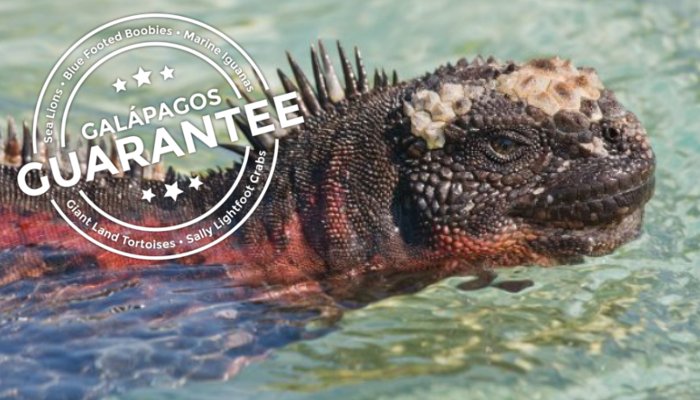
MARINE IGUANA
A Galapagos Guarantee Creature!
Galapagos marine iguanas are infamously unsightly, at least to the human eye. They weren’t given much of a chance, as many people’s first impression of the iguanas was Charles Darwin’s unflattering portrayal of creatures he found “hideous looking”; Darwin concluded they were “most disgusting, clumsy creatures.”
It’s true that unlike their sunny-colored cousins living off shore, the Galapagos marine iguanas are usually inky colored. However, they can display a variation of colors that are often dependent on which island they inhabit during their mating season. Española has the most distinct, colorful iguanas who are smudged with green, red, and copper. The unique red pigment comes from the seaweed that blossoms during the summer.
Their flat faced are dotted with wide-spread eyes and splattered with globs of salt discharged from their facial glands. Without knowing any better, it would be easy to think one was looking at a crusty lizard who had the recent misfortune of being hit with bird poop.
Although their physical features may not be pretty, they are uniquely adapted to their island environment. They use their blunt noses and sharp teeth to rake underwater algae off the rocks while their long, sharp claws help them cling to rocks onshore or off in case of heavy currents. Unlike the land iguanas, marine iguanas also have flat tails to help them swim through the water like a crocodile.
Where to find marine iguanas:
Though marine iguanas on Española are the most brightly colored, they range throughout the archipelago’s coastlines. Kayak through the habitats of these marine iguanas on our Galapagos Island Explorer tour.
FUN FACT:
The Galapagos marine iguana can hold their breath for up to 45 minutes underwater—which is good, as they prefer their meals underwater as well.
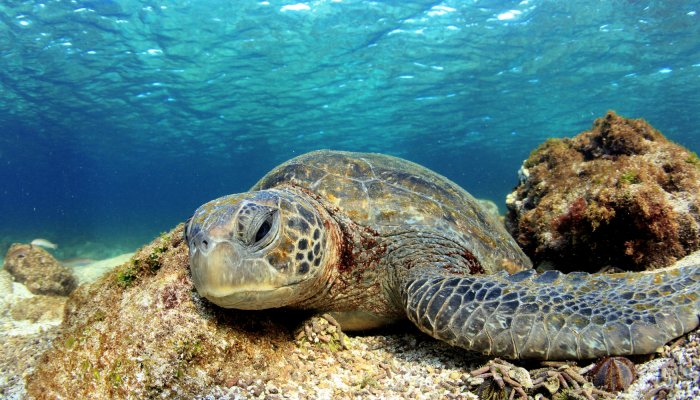
GALAPAGOS GREEN TURTLE
The green sea turtles that find their way to the Galapagos are Eastern Pacific green turtles as opposed to Atlantic green turtle. There continues to be some debate as to whether the two are distinct species or subspecies, and Eastern Pacific green turtles have become known as black sea turtles do to their different coloring. Although the Eastern Pacific green turtle has greenish skin and cartilage, their shells are more olive-brown or black.
The shells are also designed for swift swimming with their teardrop shape, tapered toward the posterior, with a slight keel. It’s a good thing that they are designed to be streamlined since they have a lot of mass to move around. Green sea turtles can weigh up to 700 pounds reach up to 5 feet in length, ranking them amongst the largest of the world’s sea turtles.
Green sea turtles are gentle giants of the sea, however. Unlike many other carnivorous sea turtles, adult green sea turtles are herbivorous with their diet of algae and sea grasses. When young, green sea turtles have a mixed diet that also includes crabs, sponges, and jellyfish.
The Galapagos shores bring masses of migrating green sea turtles to nest along the same beaches previous generations had nested on before them. Beaches are protected and occasionally closed down throughout the archipelago to protect the vulnerable hatchlings. If visitors are able to access a beach when the green sea turtles are in the area, they can occasionally see the black sea turtles leaving the protection of the sea to bask in the sun and sand. This “basking” behavior is rare amongst other sea turtles—even the Atlantic green turtle.
Where to find the Galapagos green turtle:
Galapagos green turtles are usually out and about in quiet lagoons and beaches, particularly late in the year. Black Turtle Cove on Santa Cruz Island and Isabela Island’s Elizabeth Bay are favorite spots.
Kayak with sea turtles on our Galapagos Unbound Signature Tour
FUN FACT:
Unlike their tortoise cousins, the green sea turtle’s shell makes up part of its skeleton, and therefore they can’t withdraw their heads into their shell for protection from predators.
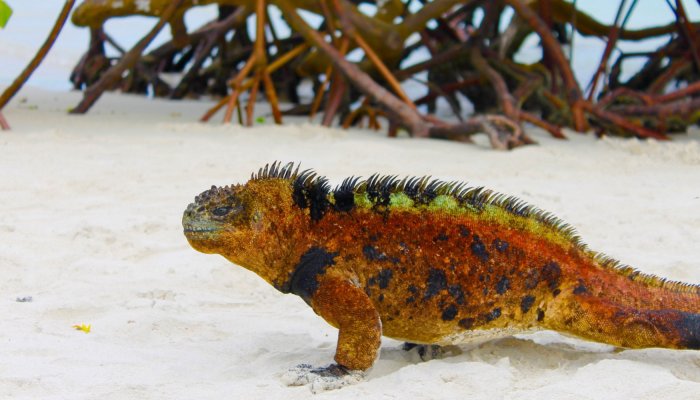
GALAPAGOS LAND IGUANA
The archipelago’s most widely distributed land iguana is the Conolophus subcristatus, or the Galapagos land iguana, which can be found on six of the Galápagos Islands. These iguanas tend to be yellow or brown with spots decorating their ventral and dorsal flanks. A spikey crest runs from its neck to its back, decorating its thick body. Unlike some other lanky lizards, the Galapagos land iguana is not a scampering, gangly reptile. They have thick bodies supported by their longer hind legs and are often crouched low to the ground as the absorb the sun’s ray’s heating the islands’ black volcanic rock.
Where to find Galapagos land iguanas:
South Plaza, Seymour, Santa Cruz, = Isabela, and Fernanda Islands.
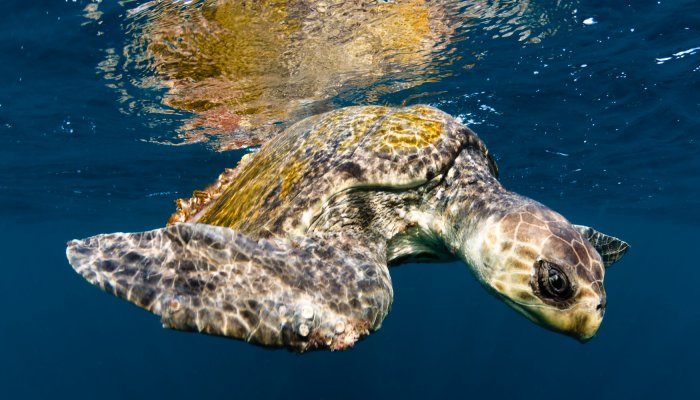
OLIVE RIDLEY TURTLE
Unlike many of the other sea turtles and tortoises found on the Galapagos, olive ridley turtles bring to mind the terms “bijou” and “dainty.” Only weighing up to 100 pounds and growing up to around 2 feet in shell length, it’s the smallest of the sea turtles. Though olive ridleys are small, they are great in number and thought to have the highest population amongst the world’s sea turtles.
Where to find the olive ridley turtle:
Though they’re plentiful, olive ridley’s are only seen in the Galapagos on rare occasions due to their pantropical distribution. It is not known to breed in the Galapagos, but they can be found in bays, estuaries, and other coastal areas
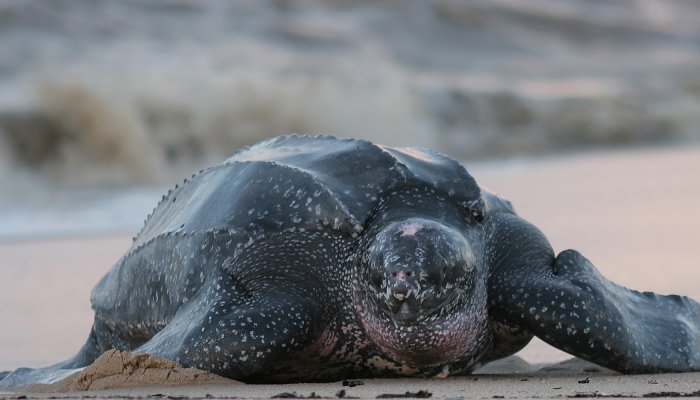
LEATHERBACK TURTLE
The leatherback has a lot of swag for a turtle, and it’s all deserved. Not only are they the oldest turtle (they’ve been around for over 150 million years and haven’t yet gone the way of the dinosaur), they also have the widest global distribution (meaning they are everywhere) of all reptiles—and possibly amongst vertebrates as well. They pop up in the Indian Oceans, the Mediterranean Sea, and the Atlantic and Pacific Oceans.
So not only have they been around forever and swim everywhere, they’re also the largest turtles on Earth (because who knows about the average size of space turtles). Leatherbacks can grow up to 8 feet long and weigh over 2,000 pounds. This gargantuan weight is part of a set of adaptations that allow them to generate and retain body heat in those cold Canadian waters they sometimes visit. Perhaps not surprisingly, these thermoregulatory adaptations are known as gigantothermy.
Where to find leatherback turtles:
Leatherbacks are the most wide-ranging of the Galapagos sea turtles, but they can be spotted foraging in the archipelago’s coastal waters.
FUN FACT:
Leatherbacks can dive deeper than 4,000ft/1,200m. Only sperm whales, elephant seals, and beaked whales are known to dive deeper..
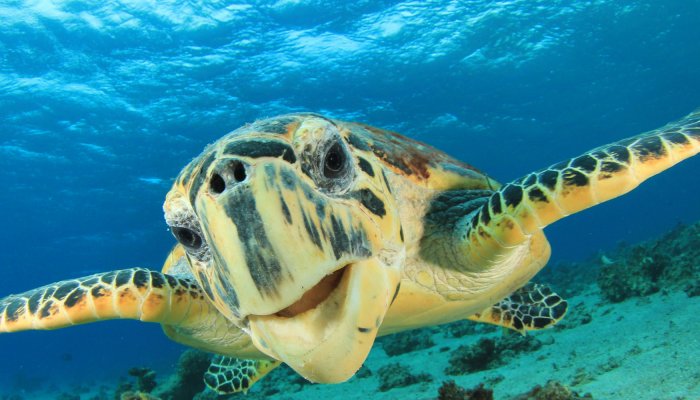
HAWKSBILL TURTLE
If you’re hoping to see an aesthetically beautiful sea turtle, the hawksbill would be your best bet. With their colored, overlapping shells decorated with unique patterns that resemble tie dye, hawksbill sea turtles are all that brought “tortoiseshell” commodities into vogue. Of course, these creatures are much a much better sight when swimming freely within tropical waters than when seen as a marketable resource.
If you don’t recognize the hawksbill sea turtle by its shell, you’ll most likely note its hooked, bird-like beak for which it’s named. It’s pointed beak, alongside its narrow head, allow it to search through a coral reef’s crevices and cracks for sponges to munch on. If they’re not swimming in coral reefs, they enjoy the shallower waters of lagoons, mangroves, and coastal and rocky areas. There, hawksbills also snack on marine algae, mollusks, sea urchins, jellyfish, fish, and crustaceans. They obviously don’t have an omnivores dilemma.
Where to find the hawksbill turtle:
Hawksbill turtles come out of the ocean to nest in pocket beaches with little sand covering.
FUN FACT:
Due to the hawksbill’s primary diet of sponge, their flesh is considered toxic to humans and, if consumed, can can lead to serious illness or, more seriously, death. In a Magic School Bus-esque scientific turn, the toxic chemical compounds found within sponges accumulate within the hawksbill’s flesh.
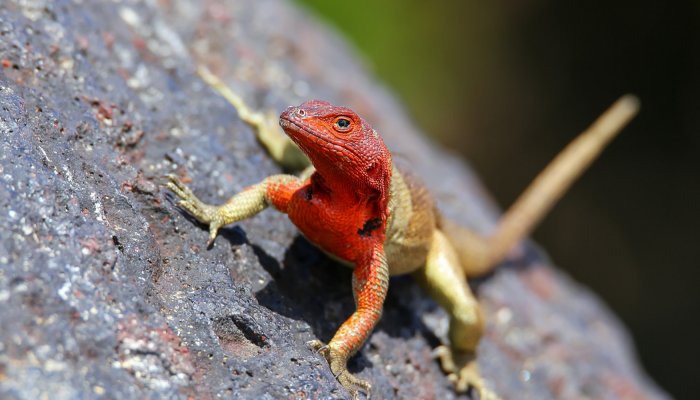
LAVA LIZARDS
Much like the Galapagos finches, Galapagos lava lizards are an excellent example of adaptive radiation. Throughout the Galapagos Islands, seven different types of endemic lava lizards can be found with variations in color, behavior, and size depending on their island habitat. Unlike the sluggish and bulky iguanas inhabiting the islands, the lava izzards are small and swift.
The male lava lizards are predominately darker with yellow and green markings, although this can change island to island. The females are more reddish in color, and when they reach maturity they exhibit bright red cheek patches. Overall, lava lizards that inhabit regions with dark lava tend to have darker coloring than those that inhabit the light, sandy beaches. Like many other lizards, lava lizards function like an animate mood ring, and their coloring reflects changes in their mood.
Lava lizard loving also tends toward the melodramatic. Commonly, males forcibly seize females by the neck and drag them for a distance to their own territory. Once there, the females are added to their harem that usually consists of 2-4 other female lava lizards. However, the females are not often compliant to the harem-lifestyle and can rebuff the male’s seduction attempts. The females either escape from the harem or can bring in another male of their own choosing to head a charge.
Where to find lava lizards:
Lava lizards can be found throughout much of the major Galapagos Islands’ lowlands excepting Genovesa, Darwin, and Wolf.
FUN FACT:
Male lava lizards may not go to the gym, but that doesn’t stop them from showing off their guns to impress the ladies. In order to show off their physical prowess, males do push-ups to attract females during mating season (although these push-ups can also resemble glorified head bobbing). Push-ups are also used to challenge rivals or to intimidate lesser males hoping for a chance with the lady. If all else fails, the males settle their differences with a slap-fight, although they prefer to use their tails to wallop one another. After all, faint heart never won fair lady.
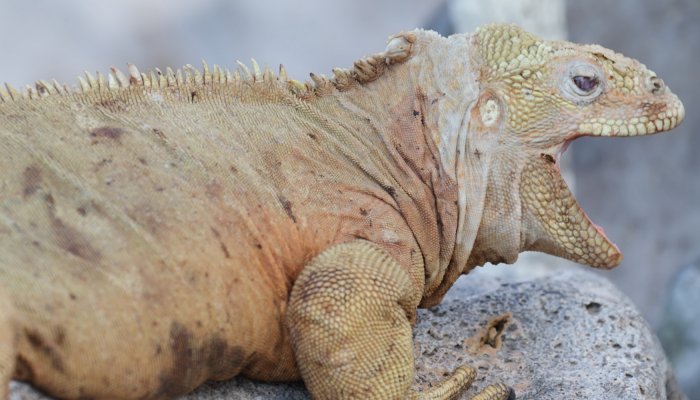
Barrington Land Iguana (Santa Fe Land Iguana)
The Galapagos is also home to the Conolophus pallidus, an iguana more commonly known as the Barrington land iguana or the Santa Fe land iguana. The Santa Fe land iguana has a much smaller habitat than its Galapagos counterpart; it can only be found on the Santa Fé island. The Santa Fe iguana is paler in color with more conspicuous dorsal spines leading to a thinner snout.
Where to find Barrington/Santa Fé land iguanas:
As the name indicates, Santa Fé land iguanas are only found on Santa Fé Island.
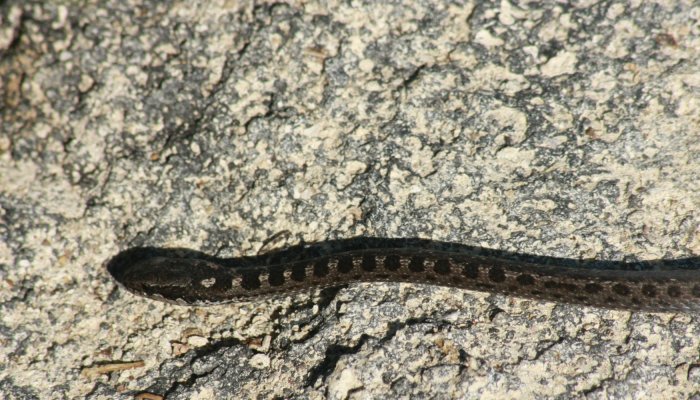
GALAPAGOS SNAKES
Four terrestrial species of snake and one marine snake, as well as several subspecies, are spread across the archipelago. They are all remarkably similar with slight variations, as are most of the animals inhabiting the archipelago, and they are commonly referred to as Galapagos ‘racers’ due to their ability to move quite quickly. Unlike the goliaths in the Ecuadorian Amazon, the Galapagos snakes are all rather small—measuring only 2-3 feet long.
Each species and subspecies inhabits different island groups. The species Charles Darwin first studied on Charles Island is now known as the Galapagos racer (Alsophis biserialis), and they can be found on Floreana, Española, and San Cristóbal. The striped Galapagos snake (Antillophis steindachneri) can be found in Fernandina, Isabela, and Pinzon Islands while the banded Galapagos snake (Antillophis slevini) can be found on Seymour, Rabida, Santiago, Puerto Egas, and Santa Cruz Islands. The Hood racer (Pseudalsophis hoodensis) has one of the most localized populations as it can only be found on Hood Island/Española.
All of the land snakes found throughout the Galapagos Islands are rather elusive, and so distribution and behavioral distinctions—especially amongst terrestrial snakes—are not well established. Despite our lack of knowledge, we do know that the majority of the snakes are considered endangered or critically endangered. Similarly, the terrestrial snakes are known to feed on a diet primarily comprised of geckos, marine and land iguanas, birds, and rats. They are all non-poisonous constrictors with mild venom who first capture their prey in their mouth before suffocating their victims.
The Yellowbelly Sea Snake, also known as the Pelagic Sea Snake, can also be spotted off of the islands’ shores, but they are not an endemic species. Instead, they are the world’s most widely distributed snake and can survive by solely inhabiting the open sea. While the upper half of its body is black, its vividly yellow belly provides it with its name. It’s paddle-shaped tail allows it to smoothly navigate the sea’s water. Though the ocean may be wide and deep, these snakes manage massive congregations. Thousands of snakes can form “slicks,” usually around debris and sea foam. Once joined, the slicks can stretch from 1-300 meters wide.
FUN FACT:
In 2014, some Galapagos locals ran over a red-and-black striped snake on Santa Cruz Island. The locals immediately recognized it as different from the four endemic, terrestrial snakes known to live throughout the Galapagos Islands and took the remains in to the Galapagos National Park (GNP). Eventually, scientists at the Charles Darwin Foundation determined the snake to be an Ecuadorian milk snake that inhabits mainland Ecuador.
Of course, it’s presence in the pristine Galapagos raises a lot of questions. Was it purposefully introduced by an unknown source? Did it belong to a small, undiscovered population native to the islands? Or, could it be an example of contemporary, instinctive species colonization that follows in the footsteps of the Galapagos’ current endemic snakes? It’s a tricky subject for herpetologists who are afraid of invasive species contaminating the isolated islands. Although the concept of natural colonization is alluring, many find it improbable.

